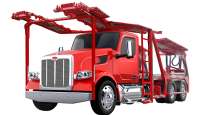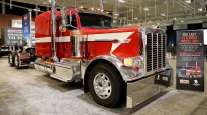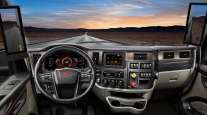Peterbilt’s Self-Driving Truck Another Glimpse Into Future

This story appears in the June 8 print edition of Transport Topics.
FORT WORTH, Texas — Peterbilt Motors Co. is the latest truck maker to demonstrate that the future of trucking is already with us, albeit in prototype, showing off Class 8s where the driver is often a spectator, cameras replace mirrors and infrared capability lights up a deer or a person on a dark night.
A Peterbilt employee started a ride around the Texas Motor Speedway here by promising it would be “really dull.” Bill Kahn, the company’s manager of advanced concepts, folded his hands in his lap, removed his foot from the brake and the bobtail tractor took off by itself on a twisting course through the track’s infield.
The truck, a modified Model 579, was guided by a GPS — accurate to within less than 2 inches — through a course that resembled a suburban setting. It sped up on straightaways and slowed into curves.
Peterbilt, a division of Bellevue, Washington-based Paccar Inc., hosted the demonstrations as part of its May 28-29 technology showcase.
PHOTO GALLERY: Peterbilt Technology Showcase
The event came shortly after the Federal Highway Administration released an Auburn University report showing that platoon trucking can increase fuel economy by 5% to 10%.
Also on site was a Peterbilt designed for Wal-Mart Transportation with four sets of cameras: forward-looking infrared that can pick up warm-blooded animals or people; units mounted to the front fender that look backward along the sides of the trailer and help a driver proceed through a tight space such as a loading dock; a fifth-wheel device to make sure a trailer’s king pin attaches properly; and four units on top of the truck that produce a bird’s-eye view of the whole rig.
Earlier in May, Freightliner Trucks demonstrated an autonomous drive on Interstate 15 in Nevada. And, Volvo Trucks followed weeks later with a presentation on platooning, which was described as only a few years away for the United States. In a platoon, a convoy of trucks linked electronically to a lead truck with an active driver cruises down the highway in a tight line — saving on fuel by lowering wind resistance.
Peterbilt General Manager Darrin Siver said that while his company is careful to be solicitous of customer desires, the research and development efforts are generated from within.
“We’re not waiting for people to ask, ‘Where can we apply that?’ We’ve got a lot of smart people here in engineering,” he said.
Kahn said Peterbilt calls the technology an “advanced driver-assist system.” It reduces active steering by the driver by 80% to 85% and requires a well-marked highway so cameras can “read” the road stripes and position the vehicle accordingly.
Siver said that while there’s more work to do for engineers, there’s also effort needed by other people.
“The technology is there and the trucks work, but there’s a lot more testing that needs to be done before we go into production,” he said.
Legal and regulatory changes must occur before the trucks can roll autonomously or in a platoon, and government changes could well be contingent upon public acceptance of the changes.
“It’s hard to say when this will become a reality. Technology curves can be funny sometimes,” Siver observed.
The original equipment manufacturer also showed how past research has influenced current trucks. Peterbilt ran two Model 579 Epiq tractors on the track. Epiq is the company’s specification package offering maximum fuel efficiency.
The report by the Federal Highway Administration found that driver-assistive truck platooning, or DATP, can realize up to 10% better fuel economy for the trailing trucks and up to 5% more for the leading vehicle.
The study, commissioned by FHWA and performed by Auburn’s engineering school, also said that truckload and linehaul less-than-truckload operations likely would benefit the most from platooning, particularly among larger carriers. Fleets and drivers who operate average truck trips of more than 500 miles would experience the highest returns on investment from platooning.
The American Transportation Research Institute also contributed to the study along with Meritor Wabco, Peloton Technology and Peterbilt.
“Regarding fuel economy, previous testing has shown that due to aerodynamic drafting effects, DATP has the potential to significantly reduce fuel use,” according to the first phase of the report.
Phase two, which starts this year, will look at results from Peterbilt rigs in platoon formation, drivers’ reactions and communications needs, among other topics.
The report said competing fleets are not inclined to collaborate in platooning, “but particularly within the private-fleet sector, the scale of noncompetitors is large. While other sectors and fleet sizes are potential target markets, the larger [over-the-road] fleets represent the early adopters that are needed to resolve key challenges and lower adoption prices through economies of scale,” the report said.
Staff Reporter Eugene Mulero contributed to this story.




